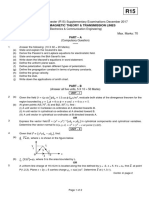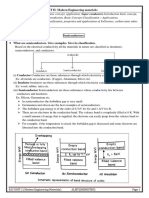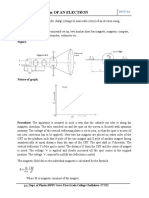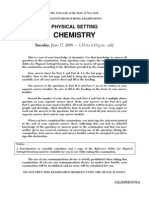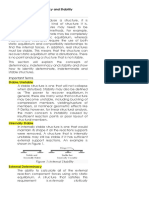Hysteresis and Eddy Current Losses PDF
Hysteresis and Eddy Current Losses PDF
Uploaded by
Venkata SubramanianCopyright:
Available Formats
Hysteresis and Eddy Current Losses PDF
Hysteresis and Eddy Current Losses PDF
Uploaded by
Venkata SubramanianOriginal Title
Copyright
Available Formats
Share this document
Did you find this document useful?
Is this content inappropriate?
Copyright:
Available Formats
Hysteresis and Eddy Current Losses PDF
Hysteresis and Eddy Current Losses PDF
Uploaded by
Venkata SubramanianCopyright:
Available Formats
SNS COLLEGE OF ENGINEERING, COIMBATORE.
DEPARTMENT OF ELECTRICAL AND ELECTRONICS ENGINEERING
EE6401-ELECTRICAL MACHINES-I
Unit.No.:1 (Magnetic Circuits & Magnetic Materials)
Topic. No.: 7
Topic: Hysteresis and eddy current losses.
Time Required: 50 Minutes
Hysteresis Loss
Consider a magnetic circuit with constant (d.c) excitation current I0. Flux established will have fixed
value with a fixed direction. Suppose this final current I0 has been attained from zero current slowly
by energizing the coil from a potential divider arrangement as depicted in Figure.1.
Let us also assume that initially the core was not magnetized. The exciting current therefore becomes
a function of time till it reached the desired current I and we stopped further increasing it. The flux too
naturally will be function of time and cause induced voltage e12 in the coil with a polarity to oppose
the increase of inflow of current as shown. The coil becomes a source of emf with terminal-1, +ve and
terminal-2, -ve. Recall that a source in which current enters through its +ve terminal absorbs power or
energy while it delivers power or energy when current comes out of the +ve terminal. Therefore
during the interval when i(t) is increasing the coil absorbs energy. Is it possible to know how much
energy does the coil absorb when current is increased from 0 to I0. This is possible if we have the B-H
curve of the material with us.
l
B
A 1 i(t) P
B0
+ + G
dB
e(t)
D.C N B
supply dH
-
- 2 O H H0 H
Figure. 2
Figure.1
Based on results obtained by experiments with different ferromagnetic materials with
sinusoidal currents, Charles Steimetz proposed the empirical formula for calculating
hysteresis loss analytically.
n
Hysteresis loss per unit volume, Ph = k h f Bmax
Where, the coefficient kh depends on the material and n, known as Steinmetz
exponent, may vary from 1.5 to 2.5. For iron it may be taken as 1.6.
Eddy Current losses
Look at the Figure.3 where a rectangular core of magnetic material is shown along with the
exciting coil wrapped around it. Without any loss of generality, one may consider this to be a part
of a magnetic circuit. If the coil is excited from a sinusoidal source, exciting current flowing will
be sinusoidal too. Now put your attention to any of the cross section of the core and imagine any
arbitrary rectangular closed path abcd. An emf will be induced in the path abcd following
Faradays law. Here of course we dont require a switch S to close the path because the path is
closed by itself by the conducting magnetic material (say iron). Therefore a circulating current
ieddy will result. The direction
of ieddy is shown at the instant when B(t ) is increasing with time. It is important to note here
that to calculate induced voltage in the path, the value of flux to be taken is the flux
enclosed by the path i.e., max = Bmax area of the loop abcd. The magnitude of the eddy
current will be limited by the path resistance , Rpath neglecting reactance effect. Eddy current
will therefore cause power loss in Rpath and heating of the core. To calculate the total eddy
current loss in the material we have to add all the power losses of different eddy paths
covering the whole cross section.
We must see that the power loss due to eddy current is minimized so that heating of the core
is reduced and efficiency of the machine or the apparatus is increased. It is obvious if the
cross sectional area of the eddy path is reduced then eddy voltage induced too will
be reduced (Eeddy area), hence eddy loss will be less. This can be achieved by using several
thin electrically insulated plates (called laminations) stacked together to form the
core instead a solid block of iron.
2 2 2
Peddy = k e f Bmax
a c
B(t) ieddy
b
Eddy current i(t)
path
Figure .3: Eddy current paths
You might also like
- Pradeep Physics Class 11 Vol 2 2023-2024Document1,020 pagesPradeep Physics Class 11 Vol 2 2023-2024laptopemail7089% (9)
- Comparison Between Magnetic and Electric CircuitDocument2 pagesComparison Between Magnetic and Electric CircuitVenkata Subramanian100% (8)
- EE97 Lab 8Document4 pagesEE97 Lab 8Ratnakar SeethiniNo ratings yet
- Dummy Coils For PickupsDocument2 pagesDummy Coils For PickupsRoland CziliNo ratings yet
- Unit 1 Lect-1 PDFDocument21 pagesUnit 1 Lect-1 PDFECE A SRM VDP100% (2)
- Semiconductor Energy Gap PDFDocument8 pagesSemiconductor Energy Gap PDFŽąsis Medina100% (1)
- Em by Thomson's MethodDocument3 pagesEm by Thomson's MethodProfessor VoltNo ratings yet
- Energy Band Gap of A Solid SemiconductorDocument6 pagesEnergy Band Gap of A Solid SemiconductorGayathripriya AseervadamNo ratings yet
- Electrical Science Unit 1Document39 pagesElectrical Science Unit 1Arka DattaNo ratings yet
- Energy Band Theory in SolidsDocument3 pagesEnergy Band Theory in Solidsashok pradhanNo ratings yet
- Compensated SemiconductorsDocument21 pagesCompensated SemiconductorsMohammad Gulam AhamadNo ratings yet
- Bphye102 Module 2Document22 pagesBphye102 Module 2amoolyarao123No ratings yet
- Carrier Transport RevisedDocument65 pagesCarrier Transport RevisedShivani GuptaNo ratings yet
- NV6106 Semiconductor Energy Gap MeasurementDocument38 pagesNV6106 Semiconductor Energy Gap MeasurementSanjana Sinha0% (1)
- Optical FiberDocument6 pagesOptical FiberSarveenaNo ratings yet
- Experiment No. 01 Objective: To Determine The Curie Temperature (TDocument4 pagesExperiment No. 01 Objective: To Determine The Curie Temperature (Tauro auroNo ratings yet
- EEE121 - Electric Circuit AnalysisDocument13 pagesEEE121 - Electric Circuit Analysisrizwanspirit11No ratings yet
- The InductorDocument25 pagesThe InductorSureshraja9977No ratings yet
- 15A04403 Electromagnetic Theory & Transmission LinesDocument2 pages15A04403 Electromagnetic Theory & Transmission LinesRadhika MahankaliNo ratings yet
- Superconductivity in Bilayer GrapheneDocument19 pagesSuperconductivity in Bilayer GrapheneScience BrainsNo ratings yet
- ET Lab ManualDocument52 pagesET Lab Manualcholleti sriram100% (1)
- Parallel ResonanceDocument4 pagesParallel ResonanceDevendra PatelNo ratings yet
- Two Marks Question With Answer Magnetic Circuits and Magnetic MaterialDocument9 pagesTwo Marks Question With Answer Magnetic Circuits and Magnetic MaterialChandra SekarNo ratings yet
- Fermi EnergyDocument7 pagesFermi EnergyBobNo ratings yet
- Optical ManualDocument26 pagesOptical ManualsharonfranklinNo ratings yet
- Wiedemann Franz LawDocument3 pagesWiedemann Franz LawAleš NagodeNo ratings yet
- LiouVille's TheoremDocument3 pagesLiouVille's TheoremMuhammad kawish iqbal100% (1)
- Revision of Plane Wave Propagation PDFDocument31 pagesRevision of Plane Wave Propagation PDFge120120No ratings yet
- Linear Integrated Circuits - EC2254Document77 pagesLinear Integrated Circuits - EC2254Muthu LakiNo ratings yet
- US01CPHY01 Unit2 Elasticity PMPDocument20 pagesUS01CPHY01 Unit2 Elasticity PMPAjay Adithya0% (1)
- NV6111Document23 pagesNV6111దేవల్ రాజు మహేష్ రాజుNo ratings yet
- Impedance of RL Circuits: Series RL Circuits: Experiment No. 2Document16 pagesImpedance of RL Circuits: Series RL Circuits: Experiment No. 2NicoNo ratings yet
- Electromagnetic Boundary ConditionDocument7 pagesElectromagnetic Boundary ConditionravindarsinghNo ratings yet
- Hot Point Probe MethodDocument5 pagesHot Point Probe MethodKANWAR JABAR SINGH GILLNo ratings yet
- CH11-fourier OpticsDocument25 pagesCH11-fourier OpticsLauren StevensonNo ratings yet
- AC SonometerDocument10 pagesAC SonometerSamiullah IlyasNo ratings yet
- Electromagnetic Waves and Transmission Lines Question PaperDocument8 pagesElectromagnetic Waves and Transmission Lines Question PaperelimelekNo ratings yet
- Instrumentation Devices Ans Systems - 1 by K.c.bhuyanDocument70 pagesInstrumentation Devices Ans Systems - 1 by K.c.bhuyanAman SrivastavaNo ratings yet
- PH6251-Engineering Physics II Question Bank With AnswersDocument58 pagesPH6251-Engineering Physics II Question Bank With Answerssridevi7350% (2)
- Andersons BridgeDocument3 pagesAndersons BridgeRamesh KumarNo ratings yet
- Unit-2 Modern Engineering MaterialsDocument19 pagesUnit-2 Modern Engineering MaterialsjdevisantoshkumarNo ratings yet
- 3.e by M by Thomson MethodDocument4 pages3.e by M by Thomson MethodashaNo ratings yet
- Kasap SM Ch01 - Solution Manual For Chapter 1 Kasap SM Ch01 - Solution Manual For Chapter 1Document72 pagesKasap SM Ch01 - Solution Manual For Chapter 1 Kasap SM Ch01 - Solution Manual For Chapter 1MUCKRAKERNo ratings yet
- Avalanche Transit Time DevicesDocument13 pagesAvalanche Transit Time Devicesuma_maduraiNo ratings yet
- Fermi LevelDocument5 pagesFermi LevelMosiour RahmanNo ratings yet
- Experiment-10 Fire Extinguishers: S&HM Lab ManualDocument7 pagesExperiment-10 Fire Extinguishers: S&HM Lab ManualYash RanaNo ratings yet
- Lecture 8 - Thermodynamic Potentials, Gibbs Free Energy, Etc-1Document61 pagesLecture 8 - Thermodynamic Potentials, Gibbs Free Energy, Etc-1BENNo ratings yet
- IV (M) QM Gamma Ray MicroscopeDocument2 pagesIV (M) QM Gamma Ray MicroscopeAbhigyan HazarikaNo ratings yet
- Chapter-4 Transient Circut Analysis Part 1Document16 pagesChapter-4 Transient Circut Analysis Part 1temesgen adugnaNo ratings yet
- Relationship Between Phase Velocity and Group VelocityDocument4 pagesRelationship Between Phase Velocity and Group Velocityjoy bakshiNo ratings yet
- Planar Inductor 1987Document3 pagesPlanar Inductor 1987Nedelcu100% (1)
- LVDTDocument11 pagesLVDTDaystar YtNo ratings yet
- Two Port NetworkDocument15 pagesTwo Port NetworkHassan AamerNo ratings yet
- SemiconductorsDocument89 pagesSemiconductorsPaapu TomNo ratings yet
- IlluminationDocument25 pagesIlluminationNikhilesh MohitNo ratings yet
- B.tech Applied Physics Lab ManualDocument87 pagesB.tech Applied Physics Lab ManualSwastika sainNo ratings yet
- Electronics PPT NotesDocument51 pagesElectronics PPT NotesKVS BalajiNo ratings yet
- Software - Experiment 1. Clipper and Clamper PDFDocument3 pagesSoftware - Experiment 1. Clipper and Clamper PDFSatadru DasNo ratings yet
- A Review of Magneto-Optic Effects and Its Application: Taskeya HaiderDocument8 pagesA Review of Magneto-Optic Effects and Its Application: Taskeya HaiderkanchankonwarNo ratings yet
- Lab RPRT EbymDocument17 pagesLab RPRT EbymMuhammad Shakeel100% (1)
- Unit-3 3. Bipolar Junction TransistorDocument31 pagesUnit-3 3. Bipolar Junction TransistorshivaniNo ratings yet
- Exp-1 To Get The Hysteresis Loop of Ferromagnetic Material.Document6 pagesExp-1 To Get The Hysteresis Loop of Ferromagnetic Material.sameerpatel15770No ratings yet
- Unit-2 Meshed SystemDocument2 pagesUnit-2 Meshed SystemVenkata SubramanianNo ratings yet
- Induced Emf PDFDocument4 pagesInduced Emf PDFVenkata SubramanianNo ratings yet
- Laws Governing Magnetic Circuits PDFDocument2 pagesLaws Governing Magnetic Circuits PDFVenkata SubramanianNo ratings yet
- WECSDocument26 pagesWECSVenkata Subramanian100% (1)
- Induction MotorDocument20 pagesInduction MotorVenkata SubramanianNo ratings yet
- Unit - No.:1 (Magnetic Circuits & Magnetic Materials) : CoimbatoreDocument3 pagesUnit - No.:1 (Magnetic Circuits & Magnetic Materials) : CoimbatoreVenkata SubramanianNo ratings yet
- EE6401 Notes PDFDocument118 pagesEE6401 Notes PDFVenkata SubramanianNo ratings yet
- Energy Savings Street Lighting EN PDFDocument38 pagesEnergy Savings Street Lighting EN PDFVenkata SubramanianNo ratings yet
- Full Report 2007Document23 pagesFull Report 2007Venkata SubramanianNo ratings yet
- Electronic Devices and Circuits Question Bank PDFDocument8 pagesElectronic Devices and Circuits Question Bank PDFVenkata Subramanian100% (1)
- Ee2254 - Linear Integrated Circuits and ApplicationsDocument125 pagesEe2254 - Linear Integrated Circuits and ApplicationsVenkata SubramanianNo ratings yet
- Chattering Phenomenon Supression of Buck Boost DC-DC Converter With Fuzzy Sliding Modes ControlDocument6 pagesChattering Phenomenon Supression of Buck Boost DC-DC Converter With Fuzzy Sliding Modes ControlVenkata SubramanianNo ratings yet
- Department of Electrical and Electronics EngineeringDocument1 pageDepartment of Electrical and Electronics EngineeringVenkata SubramanianNo ratings yet
- Control System Lab ManualDocument62 pagesControl System Lab ManualVenkata Subramanian0% (1)
- Next Previous: Fig 6.8: Normal Incidence at A Plane Boundary Plane Electromagnetic WaveDocument23 pagesNext Previous: Fig 6.8: Normal Incidence at A Plane Boundary Plane Electromagnetic WaveVenkata SubramanianNo ratings yet
- Project Guidelines: Anna UniversityDocument24 pagesProject Guidelines: Anna UniversityVenkata SubramanianNo ratings yet
- WECS1Document11 pagesWECS1Venkata Subramanian50% (2)
- Wind NotesDocument18 pagesWind NotesVenkata SubramanianNo ratings yet
- Fire Resistance of Steel StructuresDocument21 pagesFire Resistance of Steel StructuresCan AydoğmuşNo ratings yet
- Chemistry: Physical SettingDocument16 pagesChemistry: Physical SettinggnanasekarNo ratings yet
- Table: Result of Specific Gravity TestDocument3 pagesTable: Result of Specific Gravity TestBart KwanNo ratings yet
- Chemistry Winter 2a Exam KeyDocument10 pagesChemistry Winter 2a Exam KeyKaren ZhaoNo ratings yet
- Toe QuestDocument4 pagesToe Questrameshbabu_1979No ratings yet
- Che 220: Stereochemistry: Chirality & EnantiomersDocument34 pagesChe 220: Stereochemistry: Chirality & EnantiomersShadrack MaduluNo ratings yet
- ELP-1 Units and DimensionsDocument2 pagesELP-1 Units and Dimensionsayushteli.jeeprepNo ratings yet
- RM Ranker NeetDocument40 pagesRM Ranker NeetK. VAMSHI KRISHNANo ratings yet
- Physics: Topic: Motion DPP-1Document7 pagesPhysics: Topic: Motion DPP-1ShivanshNo ratings yet
- Energy Chain System E4/4 Series 5050/5150/R9850Document14 pagesEnergy Chain System E4/4 Series 5050/5150/R9850AsdgjjjNo ratings yet
- Analysis of Statically Indeterminate StructuresDocument11 pagesAnalysis of Statically Indeterminate StructuresJessa Latosa100% (1)
- Answers To Saqs: Cambridge International A Level PhysicsDocument2 pagesAnswers To Saqs: Cambridge International A Level Physicsharshanauoc100% (1)
- Cox Processes and Extensions: 3.1 Construction of Cox Processes With A Given Stochastic IntensityDocument13 pagesCox Processes and Extensions: 3.1 Construction of Cox Processes With A Given Stochastic IntensityLameuneNo ratings yet
- Moam - Info 1 Oyibos Grand Unified Theorem Revisited 5bbbcc11097c4756468b4628Document168 pagesMoam - Info 1 Oyibos Grand Unified Theorem Revisited 5bbbcc11097c4756468b4628Willie Johnson100% (1)
- Torsion em 327: Mechanics of Materials LaboratoryDocument4 pagesTorsion em 327: Mechanics of Materials LaboratoryfrankjonoNo ratings yet
- Alto Professional TS212 Spec SheetDocument2 pagesAlto Professional TS212 Spec SheetВасил МетодиевNo ratings yet
- Pre CalDocument532 pagesPre CalShafin CTSNo ratings yet
- Spintronics SeminarDocument15 pagesSpintronics Seminaranon_457450480No ratings yet
- Cover Letter Angesty Prawidyasari-13.5-DikonversiDocument2 pagesCover Letter Angesty Prawidyasari-13.5-Dikonversiangesty prawidyasariNo ratings yet
- Physics: Pearson Edexcel International Advanced LevelDocument32 pagesPhysics: Pearson Edexcel International Advanced LevelOsama HeweitatNo ratings yet
- 1.1 Fundamentals of Fluid MechanicsDocument12 pages1.1 Fundamentals of Fluid MechanicsAbid sabNo ratings yet
- Wood Shear Wall and Diaphragm DeflectionDocument2 pagesWood Shear Wall and Diaphragm DeflectionFranklin GarciaNo ratings yet
- DPP 12th Set 3-4 PDFDocument15 pagesDPP 12th Set 3-4 PDFKashvi BhatiaNo ratings yet
- HSC Model Test - 2022Document4 pagesHSC Model Test - 2022muktadir hosenNo ratings yet
- Aakash 12th Passed-JEE-Ranker Test SeriesDocument33 pagesAakash 12th Passed-JEE-Ranker Test SeriesmailtosubrataghoshNo ratings yet
- E207Document7 pagesE207Budes DanielNo ratings yet


















